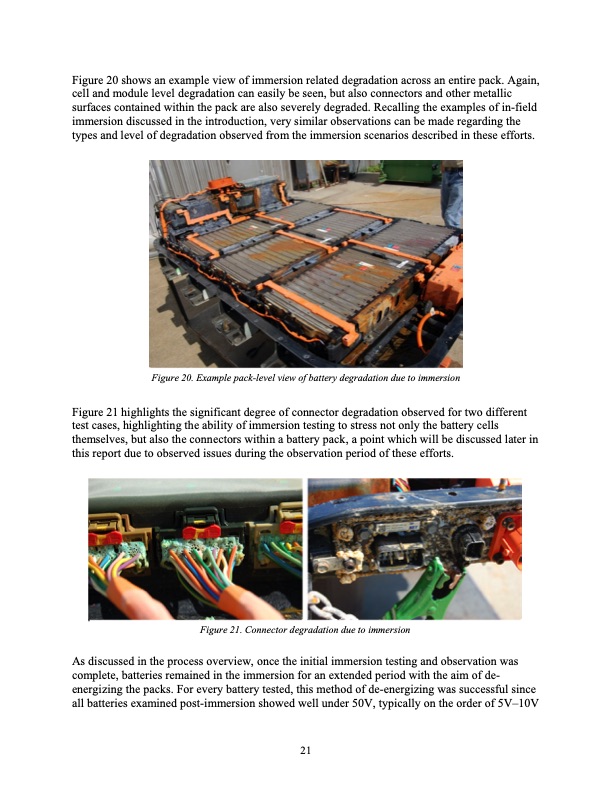
PDF Publication Title:
Text from PDF Page: 025
Figure 20 shows an example view of immersion related degradation across an entire pack. Again, cell and module level degradation can easily be seen, but also connectors and other metallic surfaces contained within the pack are also severely degraded. Recalling the examples of in-field immersion discussed in the introduction, very similar observations can be made regarding the types and level of degradation observed from the immersion scenarios described in these efforts. Figure 20. Example pack-level view of battery degradation due to immersion Figure 21 highlights the significant degree of connector degradation observed for two different test cases, highlighting the ability of immersion testing to stress not only the battery cells themselves, but also the connectors within a battery pack, a point which will be discussed later in this report due to observed issues during the observation period of these efforts. Figure 21. Connector degradation due to immersion As discussed in the process overview, once the initial immersion testing and observation was complete, batteries remained in the immersion for an extended period with the aim of de- energizing the packs. For every battery tested, this method of de-energizing was successful since all batteries examined post-immersion showed well under 50V, typically on the order of 5V–10V 21PDF Image | Li-Ion Battery Pack Immersion Exploratory Investigation

PDF Search Title:
Li-Ion Battery Pack Immersion Exploratory InvestigationOriginal File Name Searched:
dot_57013_DS1.pdfDIY PDF Search: Google It | Yahoo | Bing
Product and Development Focus for Salgenx
Redox Flow Battery Technology: With the advent of the new USA tax credits for producing and selling batteries ($35/kW) we are focussing on a simple flow battery using shipping containers as the modular electrolyte storage units with tax credits up to $140,000 per system. Our main focus is on the salt battery. This battery can be used for both thermal and electrical storage applications. We call it the Cogeneration Battery or Cogen Battery. One project is converting salt (brine) based water conditioners to simultaneously produce power. In addition, there are many opportunities to extract Lithium from brine (salt lakes, groundwater, and producer water).Salt water or brine are huge sources for lithium. Most of the worlds lithium is acquired from a brine source. It's even in seawater in a low concentration. Brine is also a byproduct of huge powerplants, which can now use that as an electrolyte and a huge flow battery (which allows storage at the source).We welcome any business and equipment inquiries, as well as licensing our flow battery manufacturing.| CONTACT TEL: 608-238-6001 Email: greg@salgenx.com | RSS | AMP |